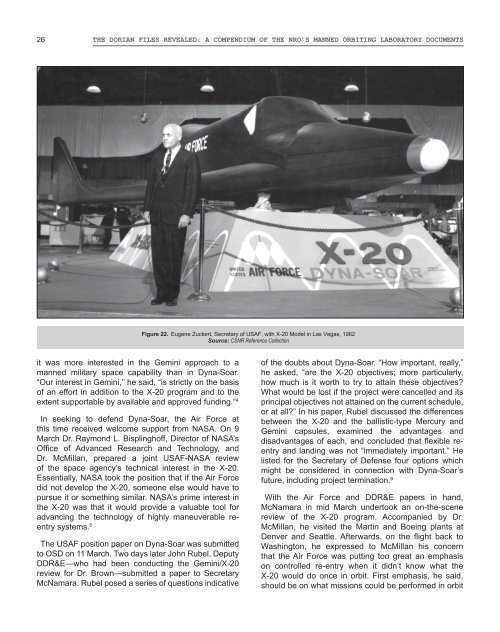NRO-MOL_2015
You also want an ePaper? Increase the reach of your titles
YUMPU automatically turns print PDFs into web optimized ePapers that Google loves.
26 The Dorian Files Revealed: a Compendium of the <strong>NRO</strong>’s Manned Orbiting Laboratory Documents<br />
Figure 22. Eugene Zuckert, Secretary of USAF, with X-20 Model in Las Vegas, 1962<br />
Source: CSNR Reference Collection<br />
it was more interested in the Gemini approach to a<br />
manned military space capability than in Dyna-Soar.<br />
“Our interest in Gemini,’’ he said, “is strictly on the basis<br />
of an effort in addition to the X-20 program and to the<br />
extent supportable by available and approved funding.” 4<br />
In seeking to defend Dyna-Soar, the Air Force at<br />
this time received welcome support from NASA. On 9<br />
March Dr. Raymond L. Bisplinghoff, Director of NASA’s<br />
Office of Advanced Research and Technology, and<br />
Dr. McMillan, prepared a joint USAF-NASA review<br />
of the space agency’s technical interest in the X-20.<br />
Essentially, NASA took the position that if the Air Force<br />
did not develop the X-20, someone else would have to<br />
pursue it or something similar. NASA’s prime interest in<br />
the X-20 was that it would provide a valuable tool for<br />
advancing the technology of highly maneuverable reentry<br />
systems. 5<br />
The USAF position paper on Dyna-Soar was submitted<br />
to OSD on 11 March. Two days later John Rubel, Deputy<br />
DDR&E—who had been conducting the Gemini/X-20<br />
review for Dr. Brown—submitted a paper to Secretary<br />
McNamara. Rubel posed a series of questions indicative<br />
of the doubts about Dyna-Soar. “How important, really,”<br />
he asked, “are the X-20 objectives; more particularly,<br />
how much is it worth to try to attain these objectives?<br />
What would be lost if the project were cancelled and its<br />
principal objectives not attained on the current schedule,<br />
or at all?” In his paper, Rubel discussed the differences<br />
between the X-20 and the ballistic-type Mercury and<br />
Gemini capsules, examined the advantages and<br />
disadvantages of each, and concluded that flexible reentry<br />
and landing was not “immediately important.” He<br />
listed for the Secretary of Defense four options which<br />
might be considered in connection with Dyna-Soar’s<br />
future, including project termination. 6<br />
With the Air Force and DDR&E papers in hand,<br />
McNamara in mid March undertook an on-the-scene<br />
review of the X-20 program. Accompanied by Dr.<br />
McMillan, he visited the Martin and Boeing plants at<br />
Denver and Seattle. Afterwards, on the flight back to<br />
Washington, he expressed to McMillan his concern<br />
that the Air Force was putting too great an emphasis<br />
on controlled re-entry when it didn’t know what the<br />
X-20 would do once in orbit. First emphasis, he said,<br />
should be on what missions could be performed in orbit

















